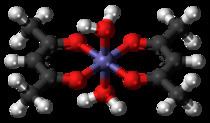Molar mass 256.91 g/mol Melting point 229.5 °C Appearance dark green | Boiling point 227 °C Density 1.46 g/cm³ | |
 | ||
Nickel(II) acetylacetonate is a coordination complex with the formula [Ni(acac)2]3, where acac is the anion C5H7O2− derived from deprotonation of acetylacetone, . It is a dark green paramagnetic solid that is soluble in organic solvents such as toluene. It reacts with water to give the blue-green diaquo complex Ni(acac)2(H2O)2.
Contents
Structure and properties
Anhydrous nickel(II) acetylacetonate exists as molecules of Ni3(acac)6. This structure is not cyclic; the three nickel atoms are approximately collinear and each pair of them is bridged by two μ2 oxygen atoms. Each nickel atom has tetragonally distorted octahedral geometry, caused by the difference in the length of the Ni-O bonds between the bridging and non-bridging oxygens. Ni3(acac)6 molecules are almost centrosymmetric, despite the non-centrosymmetric point group of the cis-Ni(acac)2 "monomers," which is uncommon. The trimeric structure allows all nickel centers to achieve an octahedral coordination. The trimer is only formed if intramolecular sharing of oxygen centers between pairs of nickel centers occurs.
When bound to bulkier analogues of acetylacetonate ligand, steric hindrance favors formation of the mononickel derivatives. This behavior is observed for the derivative of 3-methylacetylacetonate.
Dihydrate
As in the anhydrous form, the Ni(II) centres occupy octahedral coordination sites. The coordination sphere is provided by two bidentate acetylacetonate (acac) ligands and two aquo ligands. Ni(acac)2(H2O)2 exists as cis and trans isomers. The trans isomer is preferred over the cis isomer (which was only found when pyridine N-oxide was used as the solvent). In the trans isomer, the X group occupies the axial position, forming Ni-O bonds in ethanol solvents. These axial bonds are greater in length (2.1000Å) than the equatorial Ni-O bonds (2.0085 Å and 1.9961Å).
Synthesis
Bis(2,4-pentanedionato)nickel(II) is prepared by treating nickel nitrate with acetylacetone in the presence of base. The product is the blue-green diaquo complex Ni(CH3COCHCOCH3)2(H2O)2.
Ni(NO3)2 + 2 CH3COCH2COCH3 + 2 H2O + 2 NaOH → Ni(CH3COCHCOCH3)2(H2O)2 + 2 NaNO3This complex can be dehydrated using a Dean-Stark trap by azeotropic distillation:
3 Ni(CH3COCHCOCH3)2(H2O)2 → [Ni(CH3COCHCOCH3)2]3 + 6 H2OSubliming Ni(acac)2(H2O)2 at 170–210 °C under reduced pressure (0.2-0.4 mmHg) also gives the anhydrous form.
Reactions
The anhydrous complex reacts with a range of Lewis bases to give monomeric adducts:
[Ni(CH3COCHCOCH3)2]3 + 6 L → 3 Ni(CH3COCHCOCH3)2L2Ni(acac)2(H2O)2 reacts quickly in high yield at a methine positions, producing diamides from isocyanates. Related reactions occur with diethyl azodicarboxylate and dimethyl acetylenedicarboxylate:
Ni(acac)2(H2O)2 + 2 PhNCO → Ni(O2C5Me2C(O)NHPh)2 + 2 H2OThe trimer cleaves with bases such as N,N-dimethylaminoethanol and TMEDA.
[Ni(acac)2]3 + 3 chel → 3 [Ni(acac)2(chel)]Applications
The anhydrous complex is the precursor to nickel-based catalysts such as nickel bis(cyclooctadiene).
[Ni(acac)2]3 is a precursor for the deposition of NiO thin film on conductive glass substrates using sol-gel techniques.
